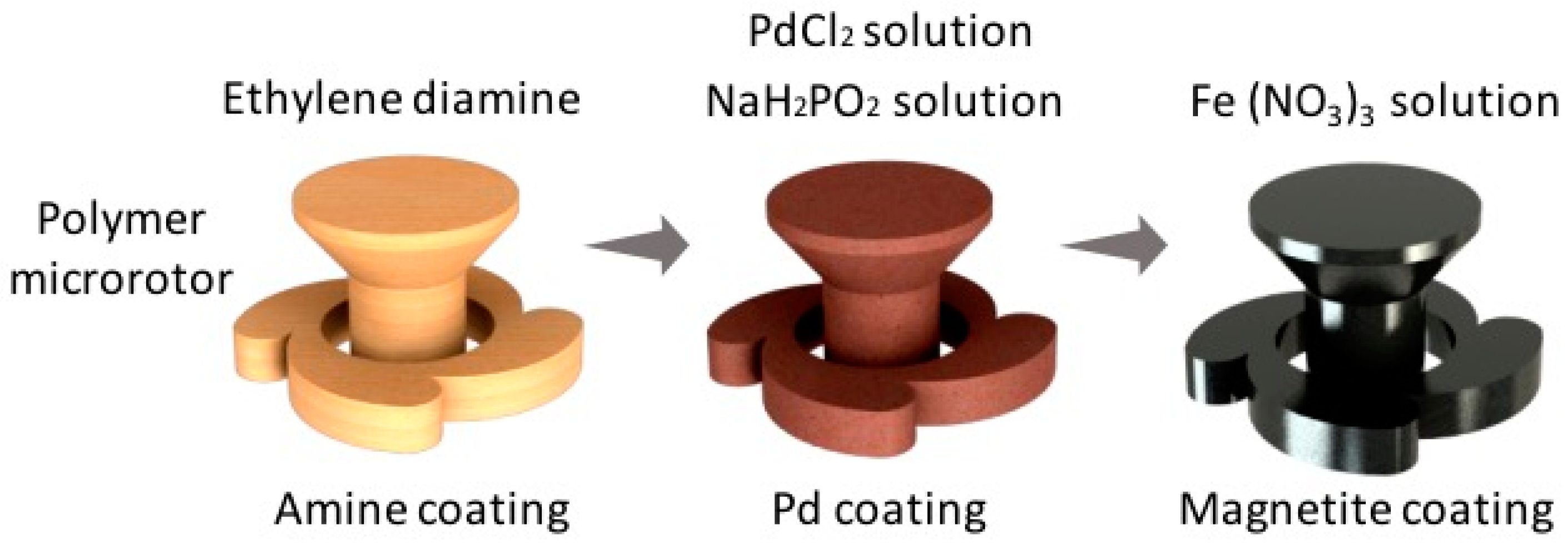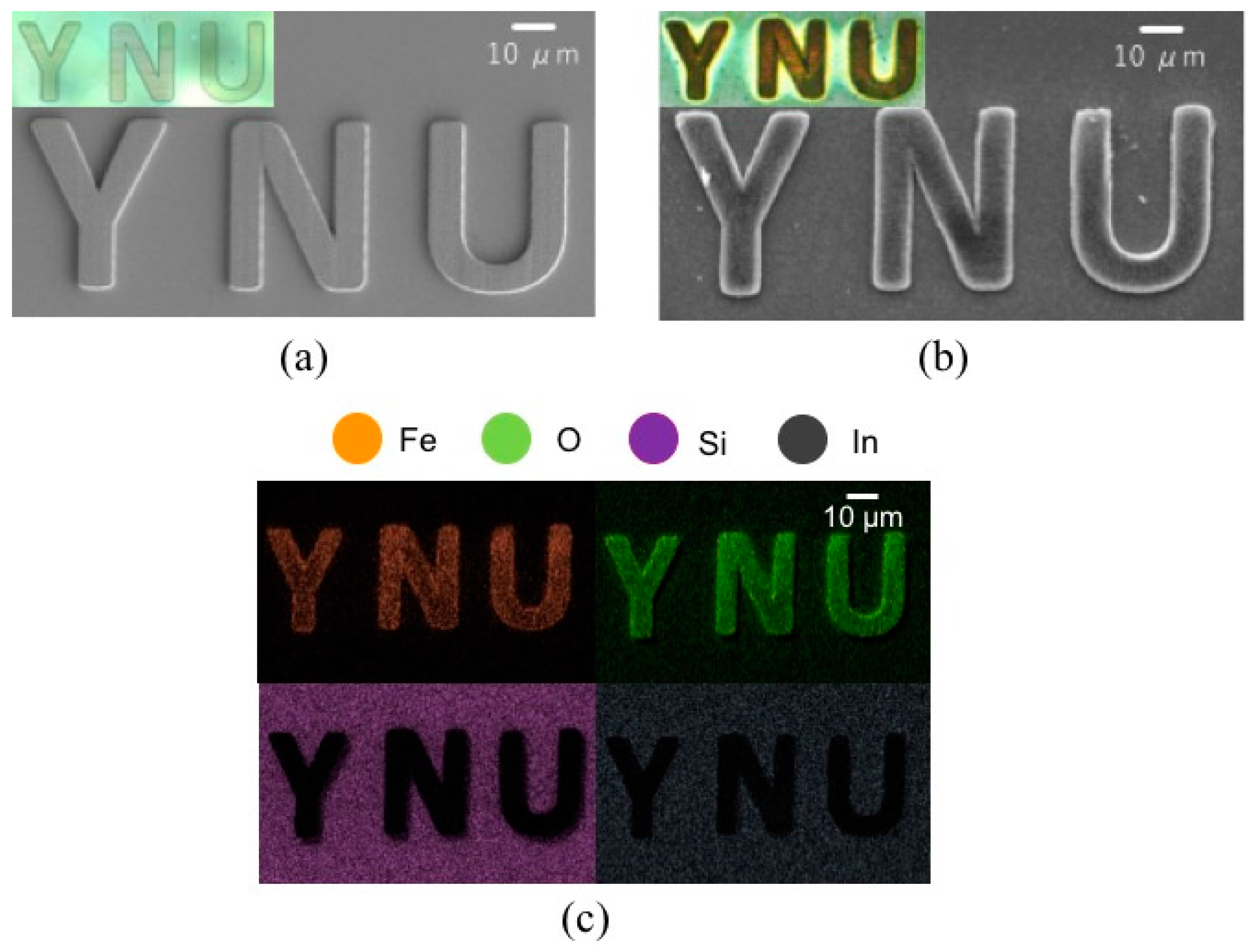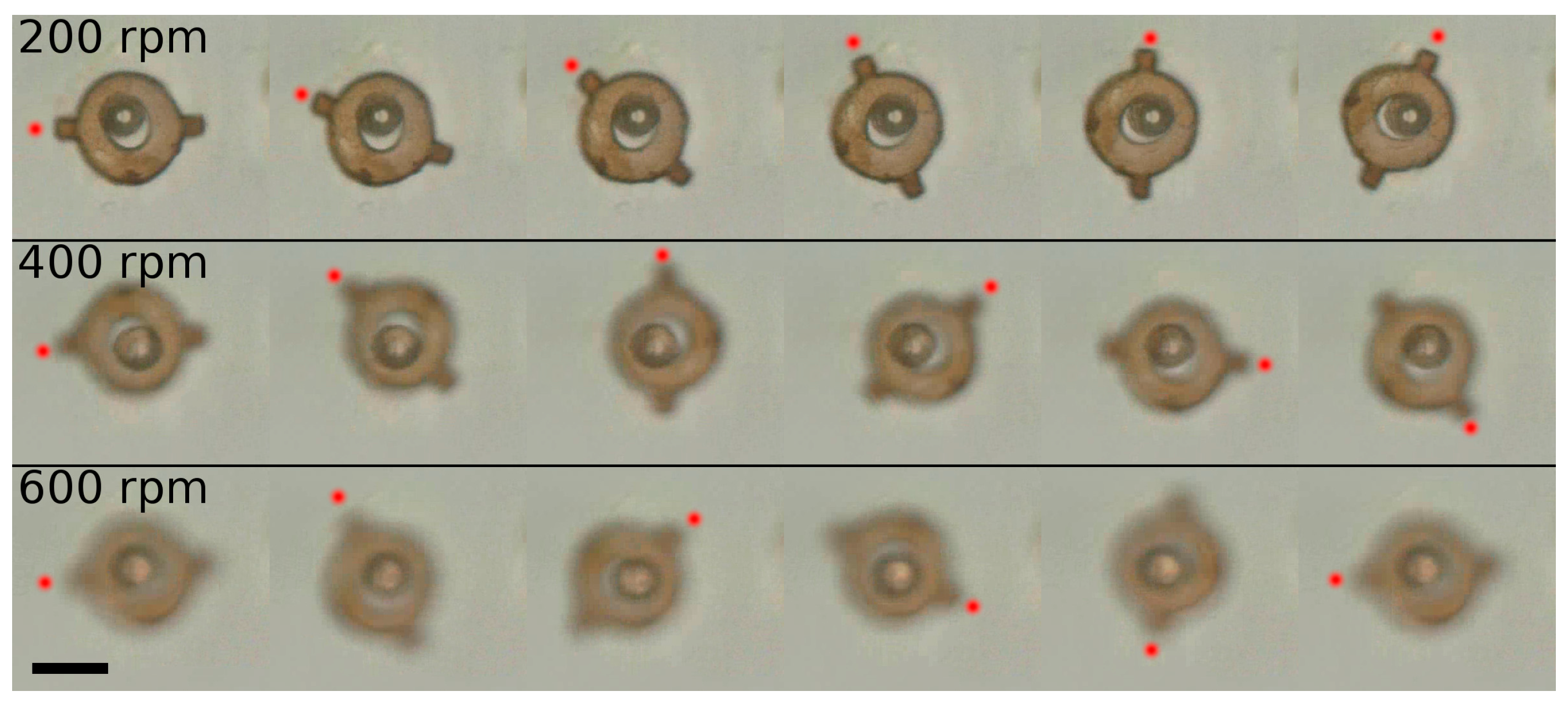Magnetically Driven Micromachines Created by Two-Photon Microfabrication and Selective Electroless Magnetite Plating for Lab-on-a-Chip Applications
Abstract
:1. Introduction
2. Materials and Methods
3. Results and Discussion
3.1. Elemental Analysis of Magnetic Microstructures Using Energy Dispersive X-ray Spectrometry (EDS)
3.2. Selective Magnetite Deposition on Polymer Microstructures
3.3. Remote Driving of Magnetite-Coated Microrotors
4. Conclusions
Supplementary Materials
Author Contributions
Conflicts of Interest
References
- Teo, E.Y.; Ong, S.-Y.; Chong, M.S.K.; Zhang, Z.; Lu, J.; Moochhala, S.; Ho, B.; Teoh, S.-H. Polycaprolactone-based fused deposition modeled mesh for delivery of antibacterial agents to infected wounds. Biomaterials 2011, 32, 279–287. [Google Scholar] [CrossRef] [PubMed]
- Van Noort, R. The future of dental devices is digital. Dent. Mater. 2012, 28, 3–12. [Google Scholar] [CrossRef] [PubMed]
- Calvert, P. Inkjet printing for materials and devices. Chem. Mater. 2001, 13, 3299–3305. [Google Scholar] [CrossRef]
- Xu, C.; Christensen, K.; Zhang, Z.; Huang, Y.; Fu, J.; Markwald, R.R. Predictive compensation-enabled horizontal inkjet printing of alginate tubular constructs. Manuf. Lett. 2013, 1, 28–32. [Google Scholar] [CrossRef]
- Sun, C.; Fang, N.; Wu, D.; Zhang, X. Projection micro-stereolithography using digital micro-mirror dynamic mask. Sens. Actuators A 2005, 121, 113–120. [Google Scholar] [CrossRef]
- Melchels, F.P.; Feijen, J.; Grijpma, D.W. A review on stereolithography and its applications in biomedical engineering. Biomaterials 2010, 31, 6121–6130. [Google Scholar] [CrossRef] [PubMed] [Green Version]
- Cumpston, B.H.; Ananthavel, S.P.; Barlow, S.; Dyer, D.L.; Ehrlich, J.E.; Erskine, L.L.; Heikal, A.A.; Kuebler, S.M.; Lee, I.-Y.S.; McCord-Maughon, D.; et al. Two-photon polymerization initiators for three-dimensional optical data storage and microfabrication. Nature 1999, 398, 51–54. [Google Scholar]
- Maruo, S.; Takaura, A.; Saito, Y. Optically driven micropump with a twin spiral microrotor. Opt. Express 2009, 17, 18525–18532. [Google Scholar] [CrossRef]
- Klein, F.; Striebel, T.; Fischer, J.; Jiang, Z.; Franz, C.M.; von Freymann, G.; Wegener, M.; Bastmeyer, M. Elastic fully three-dimensional microstructure scaffolds for cell force measurements. Adv. Mater. 2010, 22, 868–871. [Google Scholar] [CrossRef] [PubMed]
- Ovsianikov, A.; Schlie, S.; Ngezahayo, A.; Haverich, A.; Chichkov, B.N. Two-photon polymerization technique for microfabrication of CAD-designed 3D scaffolds from commercially available photosensitive materials. J. Tissue Eng. Regen. Med. 2007, 1, 443–449. [Google Scholar] [CrossRef] [PubMed]
- Maruo, S.; Ikuta, K.; Korogi, H. Force-controllable, optically driven micromachines fabricated by single-step two-photon microstereolithography. J. Microelectromech. Syst. 2003, 12, 533–539. [Google Scholar] [CrossRef]
- Ikegami, T.; Ozawa, R.; Stocker, M.P.; Monaco, K.; Fourkas, J.T.; Maruo, S. Development of optically-driven metallic microrotors using two-photon microfabrication. J. Laser Micro Nanoeng. 2013, 8, 6–10. [Google Scholar] [CrossRef]
- Maruo, S.; Nakamura, O.; Kawata, S. Three-dimensional microfabrication with two-photon-absorbed photopolymerization. Opt. Lett. 1997, 22, 132–134. [Google Scholar] [CrossRef] [PubMed]
- Zhou, W.; Kuebler, S.M.; Braun, K.L.; Yu, T.; Cammack, J.K.; Ober, C.K.; Perry, J.W.; Marder, S.R. An efficient two-photon-generated photoacid applied to positive-tone 3D microfabrication. Science 2002, 296, 1106–1109. [Google Scholar] [CrossRef] [PubMed]
- Pitts, J.D.; Campagnola, P.J.; Epling, G.A.; Goodman Steven, L. Submicron multiphoton free-form fabrication of proteins and polymers: studies of reaction efficiencies and applications in sustained release. Macromolecules 2000, 33, 1514–1523. [Google Scholar] [CrossRef]
- Wang, J.; Xia, H.; Xu, B.-B.; Niu, L.-G.; Wu, D.; Chen, Q.-D.; Sun, H.-B. Remote manipulation of micronanomachines containing magnetic nanoparticles. Opt. Lett. 2009, 34, 581–583. [Google Scholar] [CrossRef] [PubMed]
- Farrer, R.A.; LaFratta, C.N.; Li, L.; Praino, J.; Naughton, M.J.; Saleh, B.E.A.; Teich, M.C.; Fourkas, J.T. Selective functionalization of 3-D polymer microstructures. J. Am. Chem. Soc. 2006, 128, 1796–1797. [Google Scholar] [CrossRef] [PubMed]
- Ikegami, T.; Stocker, M.P.; Monaco, K.; Fourkas, J.T.; Maruo, S. Fabrication of Three-dimensional metalized movable microstructures by the combination of two-photon microfabrication and electroless plating. Jpn. J. Appl. Phys. 2012, 51, 06FL17. [Google Scholar] [CrossRef]
- Tian, Q.H.; Guo, X.Y. Electroless copper plating on microcellular polyurethane foam. Trans. Nonferr. Met. Soc. China 2010, 20, s283–s287. [Google Scholar] [CrossRef]
- Hu, J.; Li, W.; Chen, J.; Zhang, X.; Zhao, X. Novel plating solution for electroless deposition of gold film onto glass surface. Surf. Coat. Technol. 2008, 202, 2922–2926. [Google Scholar] [CrossRef]
- Tian, Y.; Zhang, Y.-L.; Ku, J.F.; He, Y.; Xu, B.-B.; Chen, Q.D.; Xia, H.; Sun, H.B. High performance magnetically controllable microturbines. Lab Chip 2010, 10, 2902–2905. [Google Scholar] [CrossRef] [PubMed]
- Wang, W.-K.; Sun, Z.B.; Zheng, M.L.; Dong, X.-Z.; Zhao, Z.S.; Duan, X.M. Magnetic nickel–phosphorus/polymer composite and remotely driven three-dimensional micromachine fabricated by nanoplating and two-photon polymerization. J. Phys. Chem. C 2011, 115, 11275–11281. [Google Scholar] [CrossRef]
- Nakanishi, T.; Masuda, Y.; Koumoto, K. Site-selective deposition of magnetite particulate thin films on patterned self-assembled monolayers. Chem. Mater. 2004, 16, 3484–3488. [Google Scholar] [CrossRef]
- Taniguchi, S.; Maruo, S. Remotely driven micromachines produced by two-photon microfabrication. In Three-Dimensional Microfabrication Using Two-Photon Polymerization: Fundamentals, Technology, and Applications, 1st ed.; Baldacchini, T., Ed.; William Andrew: Kidlington, UK, 2015; pp. 293–309. [Google Scholar]






| Coating Parameter | Experimental Range | Optimal Range |
|---|---|---|
| Bath temperature (°C) | 20–80 | 60–70 |
| pH | 3.0–5.0 | 3.5–4.5 |
| Fe3+ (mol/L) | 0.001–10.0 | 0.01–1.0 |
© 2017 by the authors. Licensee MDPI, Basel, Switzerland. This article is an open access article distributed under the terms and conditions of the Creative Commons Attribution (CC BY) license ( http://creativecommons.org/licenses/by/4.0/).
Share and Cite
Zandrini, T.; Taniguchi, S.; Maruo, S. Magnetically Driven Micromachines Created by Two-Photon Microfabrication and Selective Electroless Magnetite Plating for Lab-on-a-Chip Applications. Micromachines 2017, 8, 35. https://doi.org/10.3390/mi8020035
Zandrini T, Taniguchi S, Maruo S. Magnetically Driven Micromachines Created by Two-Photon Microfabrication and Selective Electroless Magnetite Plating for Lab-on-a-Chip Applications. Micromachines. 2017; 8(2):35. https://doi.org/10.3390/mi8020035
Chicago/Turabian StyleZandrini, Tommaso, Shuhei Taniguchi, and Shoji Maruo. 2017. "Magnetically Driven Micromachines Created by Two-Photon Microfabrication and Selective Electroless Magnetite Plating for Lab-on-a-Chip Applications" Micromachines 8, no. 2: 35. https://doi.org/10.3390/mi8020035





